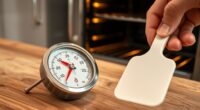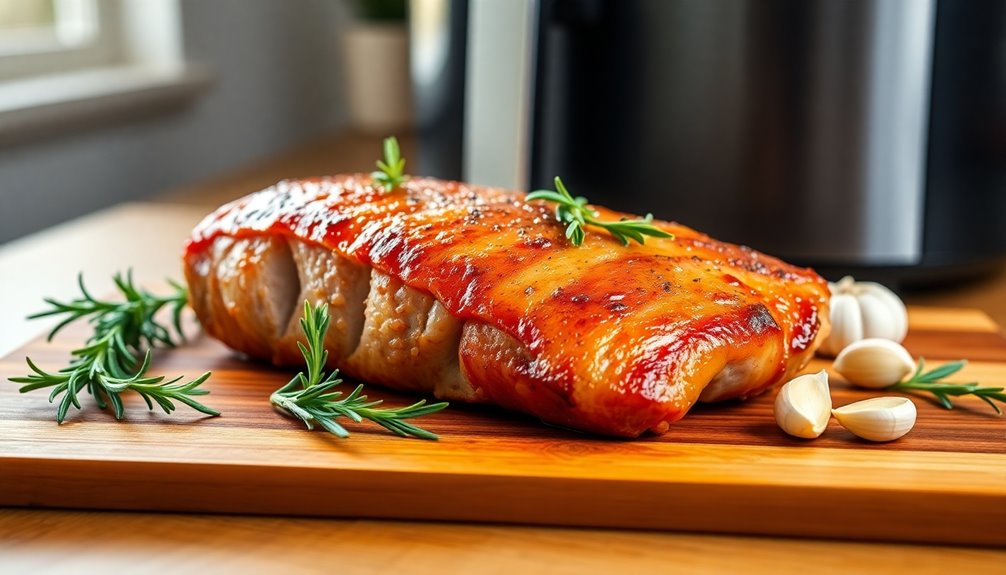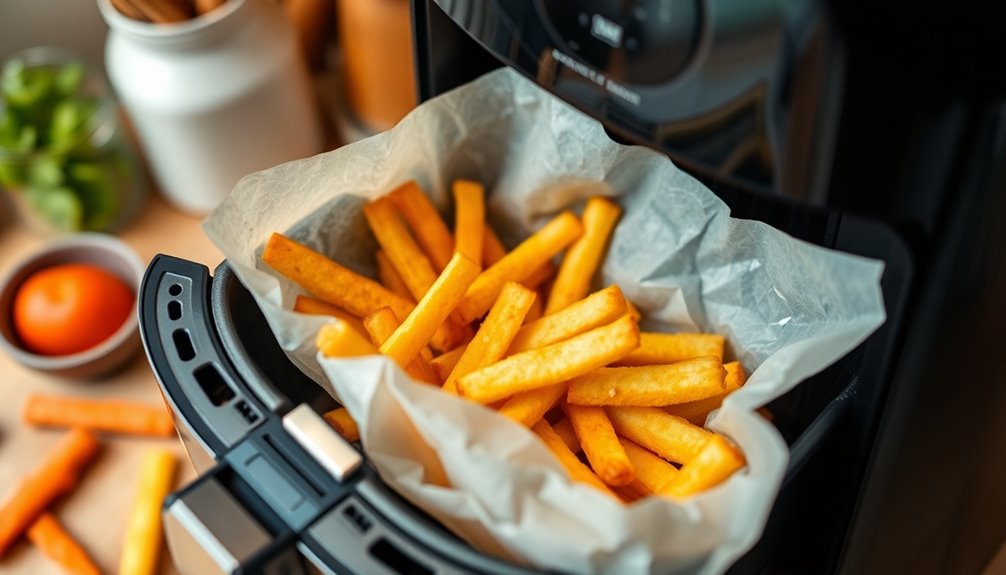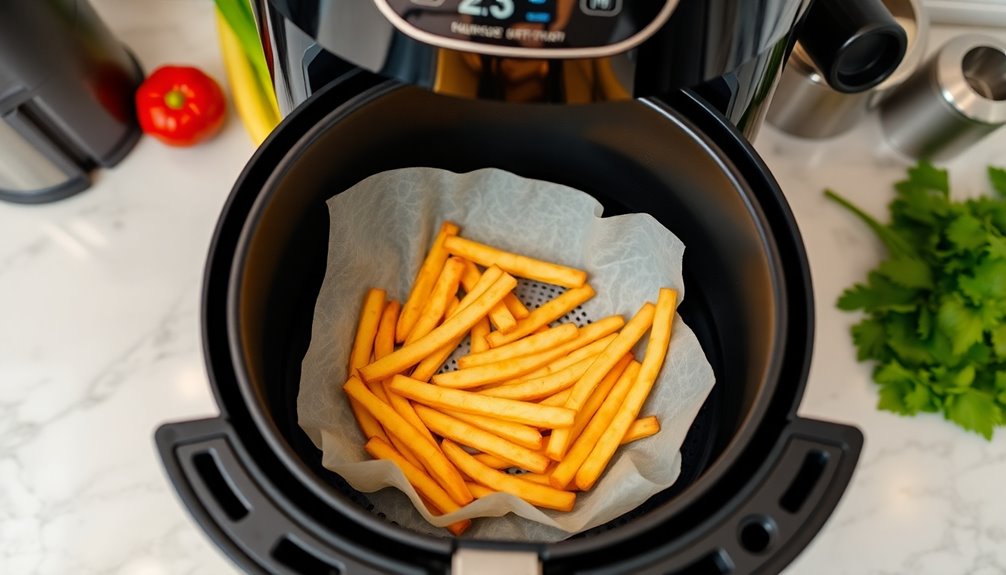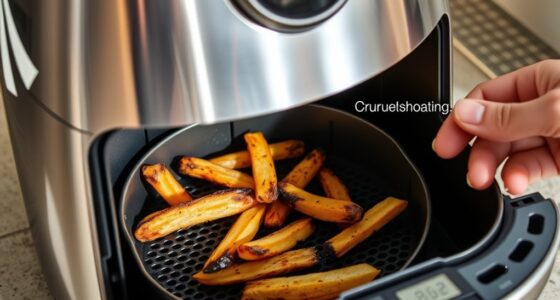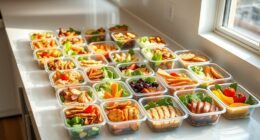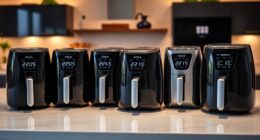To adjust air fryer cooking times, start with standard recipes as your baseline. Keep in mind that food size, thickness, and quantity impact cooking times—thinner or smaller portions cook faster, while larger pieces need more time. Use timers and monitor food for doneness, making small adjustments (1-3 minutes) as needed. Document your tweaks to perfect your process over time. For detailed tips on customizing times for various foods, continue exploring the key strategies.
Key Takeaways
- Start with standard recipe times and monitor food closely for doneness, adjusting by 1-3 minutes as needed.
- Increase cooking time by 10-15% when overcrowding or cooking larger quantities for even results.
- Reduce time when cooking thinner or smaller food pieces, as they heat faster.
- Shake, flip, or reposition food midway to promote uniform cooking and prevent over- or undercooking.
- Keep a cooking log of adjustments to refine timing and temperature for consistent future results.
Understanding Your Air Fryer’s Unique Characteristics

Since each air fryer model has its own design and features, understanding these differences is key to cooking successfully. You’ll notice that some models cook faster or more evenly than others. For example, the size and shape of the basket affect airflow and heat distribution. Some air fryers have adjustable temperature and timers, while others may have preset settings. Material differences, like ceramic versus non-stick coatings, can influence cooking times and cleanup. Knowing your appliance’s wattage helps you gauge how quickly it heats up and cooks food. Paying attention to how your specific model responds to different foods and recipes can help you make more precise adjustments. Recognizing the air fryer’s capacity can help you adjust cooking times accordingly for better results. Additionally, understanding the air fryer’s heat distribution can further optimize your cooking process. Moreover, being aware of the air fryer’s unique features, such as convection fan speed or additional cooking modes, allows for more accurate time and temperature adjustments. By understanding these characteristics, you’ll be better equipped to adjust times and temperatures for perfect results every time.
A better understanding of air fryer’s performance metrics can also guide you in refining your cooking techniques for consistent outcomes.
Recognizing the Importance of Food Size and Thickness

The size and thickness of your food directly impact how it cooks in the air fryer. Thicker or larger pieces take longer to heat through and reach a safe, crispy exterior. If you cut your chicken breasts into thinner cutlets, they’ll cook faster and more evenly. Conversely, whole vegetables or thick steaks need extra time to cook thoroughly. Uniformity is key; uneven pieces won’t cook at the same rate, resulting in burnt edges or undercooked centers. To guarantee consistent results, adjust your cooking time based on the size and thickness of each piece. Using smaller, thinner portions helps you achieve crispy, evenly cooked food without overcooking. Always consider food dimensions before setting your timer to avoid surprises. Additionally, understanding food size and thickness can help you better tailor your cooking process for optimal results. Paying attention to food safety guidelines ensures all portions are cooked to a safe internal temperature. Recognizing the impact of food dimensions on cooking time is crucial for achieving perfect results every time.
Using Standard Recipes as a Starting Point
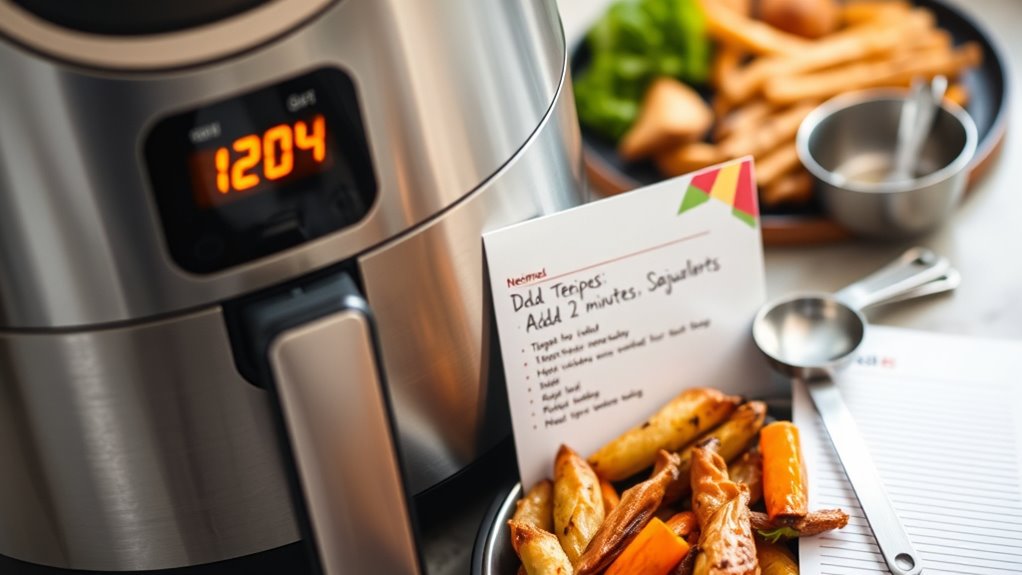
Starting with standard recipes provides a reliable baseline for your air fryer cooking, helping you achieve consistent results. These recipes give you a solid starting point, so you can focus on making adjustments rather than figuring out times and temperatures from scratch. Using a farmhouse-inspired layout can also enhance your kitchen environment, making it more inviting and functional for everyday use. To get started:
- Select a trusted recipe that matches your food type and portion size.
- Follow the recommended temperature and cooking time initially.
- Monitor the outcome and note any differences from your expectations.
Using standard recipes saves you guesswork and guarantees your food is cooked properly. Once you’re comfortable, you can tweak times and temperatures to better suit your specific air fryer model and personal preferences.
Adjusting Cooking Times Based on Food Quantity

When cooking larger or smaller quantities in your air fryer, you need to modify the cooking times accordingly to guarantee your food turns out perfectly. If you’re cooking more than a single serving, overcrowding the basket can block airflow, leading to uneven cooking. To prevent this, increase the cooking time slightly—by about 10-15%—and shake or flip the food midway. Conversely, if you’re preparing less food, reduce the cooking time slightly since there’s less food mass to heat through. Keep in mind that thin layers cook faster than stacked or piled foods. Proper airflow circulation is essential for achieving crispy and evenly cooked results. Ensuring consistent cooking conditions helps maintain optimal results. When adjusting cooking times, consider how food composition may affect heat transfer and cooking efficiency. Always check for doneness before removing, as variations in quantity can affect cooking speed. Adjusting times ensures your food is crispy, evenly cooked, and delicious every time.
Monitoring and Tweaking During Cooking

Monitoring your food closely during air frying allows you to catch any signs of overcooking or undercooking early on. This proactive approach helps you make real-time adjustments to ensure perfect results. Keep an eye on the color, texture, and smell as indicators of doneness. If you notice food browning too quickly, reduce the temperature or open the basket to check. Conversely, if it’s not cooking evenly, shake or flip the items. To stay on top, consider these tips:
- Check food midway through the cooking process.
- Adjust temperature or time based on appearance and progress.
- Use a food thermometer for precise doneness, especially for meats.
Considering Different Food Types and Textures

Since different food types and textures respond uniquely to air frying, it’s important to adjust your approach accordingly. For instance, thicker cuts of meat may need longer cooking times, while delicate vegetables cook quickly and require shorter durations. Crispy foods like fried items benefit from higher temperatures and shorter times to prevent burning, whereas softer foods like fish fillets need gentler heat and more time to cook through evenly. Recognizing that dense foods such as potatoes or breaded items may need extra time to achieve crispiness, while leafy greens or thin slices cook rapidly and can dry out if overdone. Additionally, understanding the impact of food density on cooking times can help optimize your air frying results for various ingredients. Adjusting cooking times based on food density can lead to better texture and doneness, reducing the risk of undercooking or overcooking. Proper ventilation during cooking can also influence the cooking process by ensuring even heat distribution. Incorporating heat transfer principles into your planning can further improve the consistency of your results.
Utilizing Cooking Timers and Alerts Effectively

Using your air fryer’s timers and alerts can make cooking more accurate and stress-free. Make sure you set precise timers and use alerts to stay on top of each step. If you’re managing multiple devices, organize your timers so nothing gets overlooked. Incorporating support breakfast ideas can also inspire you to prepare quick and nutritious meals alongside your air frying tasks. Additionally, understanding the ideal cooking times for different foods ensures optimal results and helps prevent overcooking or undercooking. Being aware of essential oil benefits can also enhance your cooking experience by creating a calming or invigorating atmosphere during meal prep. Moreover, familiarizing yourself with watering tips for indoor plants can help create a more relaxing environment in your kitchen or dining space.
Setting Accurate Timers
Accurate timing is essential when using an air fryer to guarantee your food cooks perfectly without overdoing it. To set the right timers, focus on precision and consistency. First, always double-check your recipe’s recommended cooking time and adjust if needed based on your air fryer’s performance. Second, use your air fryer’s built-in timer or a reliable external timer to track cooking time accurately. Third, monitor your progress periodically, especially during the last few minutes, to prevent overcooking. Remember, small adjustments in timing can make a big difference in texture and flavor. Properly setting and adhering to timers ensures you achieve crisp, tender results without guesswork. Additionally, understanding cooking techniques can help you refine your timing and achieve consistent results. Being aware of your specific air fryer model’s quirks and performance characteristics can further enhance your cooking accuracy and appliance maintenance.
Using Alerts Wisely
To make the most of your air fryer, you should leverage its alerts and timers effectively, guaranteeing your food is cooked perfectly every time. Set timers carefully based on your recipe’s adjusted times, and pay attention to the alerts to avoid overcooking or undercooking. Use alerts as a reminder to check on your food, especially for delicate items or when nearing the end of cooking. If your air fryer allows multiple alerts, customize them for different stages—such as halfway through cooking or when reaching target temperature. Don’t ignore alerts; they’re designed to help you stay attentive without constantly monitoring, freeing you to prepare sides or sauces. Properly utilizing alerts ensures consistent results and prevents food from burning or drying out.
Managing Multiple Devices
Managing multiple air fryer devices at once can be challenging, but leveraging their cooking timers and alerts effectively makes the process smoother. First, set each device’s timer immediately when you start cooking, so you stay aware of their progress. Second, name or label your timers if your app allows, helping you identify which alert corresponds to each dish. Third, use audible alerts to notify you when a cycle ends, preventing overcooking or burning. To stay organized, create a cooking schedule, noting the start times and durations for each device. This way, you can prioritize tasks and avoid overlapping alerts. By managing timers proactively, you keep multiple devices running efficiently, ensuring perfectly cooked dishes without constant supervision.
Making Incremental Adjustments for Best Results

To get the best results, keep an eye on your food as it cooks and note how it looks. Make small adjustments to the cooking time rather than large ones, so you don’t overshoot. Keep a record of what works so you can easily replicate success in future recipes.
Monitor Cooking Progress
Keeping a close eye on your air fryer while cooking allows you to make timely adjustments that prevent over- or under-cooking. Regularly checking the progress helps you catch signs of doneness early, ensuring perfect results. Use these strategies:
- Visual cues – look for browning, bubbling, or texture changes to assess doneness.
- Touch test – gently press the food to check firmness or tenderness.
- Temperature checks – use a meat or food thermometer for precise internal temps.
Adjust Time Gradually
When monitoring your air fryer during cooking, small adjustments can make a big difference in achieving perfect results. Instead of changing the cooking time drastically, add or subtract 1 to 3 minutes at a time. This approach helps you avoid overcooking or undercooking your food. For example, if your fries aren’t crispy enough after the recommended time, add a little extra time in 1-minute increments. Conversely, if your chicken is overdone, cut back slightly on the next attempt. Keep track of each adjustment to learn your air fryer’s nuances. Patience is key; incremental changes allow you to fine-tune your cooking process without risking mishaps. Over time, you’ll develop a feel for the ideal timing for different recipes.
Record Successful Times
Recording the times that yield the best results is essential for refining your air fryer cooking process. By keeping track of successful cooking times, you create a reliable reference for future attempts. This practice helps you identify patterns and avoid unnecessary trial and error. To make the most of this, consider these steps:
- Note the exact time and temperature when you achieve perfect results.
- Record any adjustments you made, such as ingredient tweaks or rack positions.
- Compare results over multiple tries to determine the most consistent times.
Maintaining a cooking log ensures you can quickly replicate successful outcomes and fine-tune your process. Over time, this systematic approach boosts your confidence and helps you consistently produce delicious air-fried dishes.
Documenting Your Adjustments for Future Use

Taking the time to document your adjustments guarantees you can replicate successful results and refine your process over time. By keeping detailed notes, you create a reference for future recipes, ensuring consistency. Record specifics like temperature, time, and any tweaks you made. Use a simple chart to stay organized:
| Ingredient/Recipe | Adjustments Made |
|---|---|
| Chicken Wings | Added 2 minutes, increased temp to 400°F |
| Frozen Fries | Reduced time by 3 minutes, kept temp at 375°F |
| Vegetables | Used lower temp, checked every 5 mins |
This method helps you identify patterns, avoid trial-and-error, and perfect your process. Over time, your notes become a valuable resource, making every air fryer session more predictable and successful.
Frequently Asked Questions
How Do I Know if My Air Fryer Runs Hot or Cold?
If you’re unsure whether your air fryer runs hot or cold, start by testing it with a simple task. Place a small amount of food or a thermometer inside and run it at a standard temperature. Check the results after a few minutes. If the food cooks faster or slower than expected, or if the temperature reading is off, you might need to calibrate or adjust your air fryer for accurate cooking.
Can I Use Recipes Designed for Ovens in My Air Fryer?
You can use oven recipes in your air fryer, but you’ll need to make some adjustments. Since air fryers cook faster and more intensely, reduce the temperature by about 25°F and cut the cooking time by roughly 20%. Keep an eye on your food as it cooks, and check for doneness early. Experimenting with small batches helps you find the perfect timing and temperature for your air fryer.
How Do I Adjust Cooking Times for Frozen Versus Fresh Foods?
When cooking frozen versus fresh foods in your air fryer, you should anticipate longer cooking times for frozen items because they’re colder and need more heat to cook through. Start by adding about 50% more time than you would for fresh, then check for doneness. Shake or flip the food halfway through to ensure even cooking. Always monitor closely to prevent overcooking or burning.
What’S the Best Way to Prevent Food From Drying Out?
To prevent food from drying out in your air fryer, you should keep an eye on cooking times and temperatures. Use a light spray of oil to add moisture and help retain juiciness. Avoid overcrowding the basket, which can lead to uneven cooking and dryness. Consider covering delicate foods with foil or adding a small amount of broth or sauce to maintain moisture throughout the cooking process.
How Often Should I Check on Food During Cooking?
Imagine your air fryer as a vigilant guardian watching over your meal. You should check on your food about halfway through the cooking process, especially for new recipes or delicate items. This way, you catch any signs of overcooking early, like a gentle whisper instead of a loud shout. Regular checks help you fine-tune the timing, ensuring your dish turns out crispy and perfect without a hint of dryness.
Conclusion
By understanding your air fryer’s quirks, recognizing food differences, and making small, mindful adjustments, you’ll master perfect results every time. Trust your observations, monitor closely, and tweak as needed. Keep notes on what works best for different foods and quantities. With patience and practice, you’ll turn cooking with your air fryer into a simple, enjoyable process—one where consistency, confidence, and delicious meals become your everyday routine.

